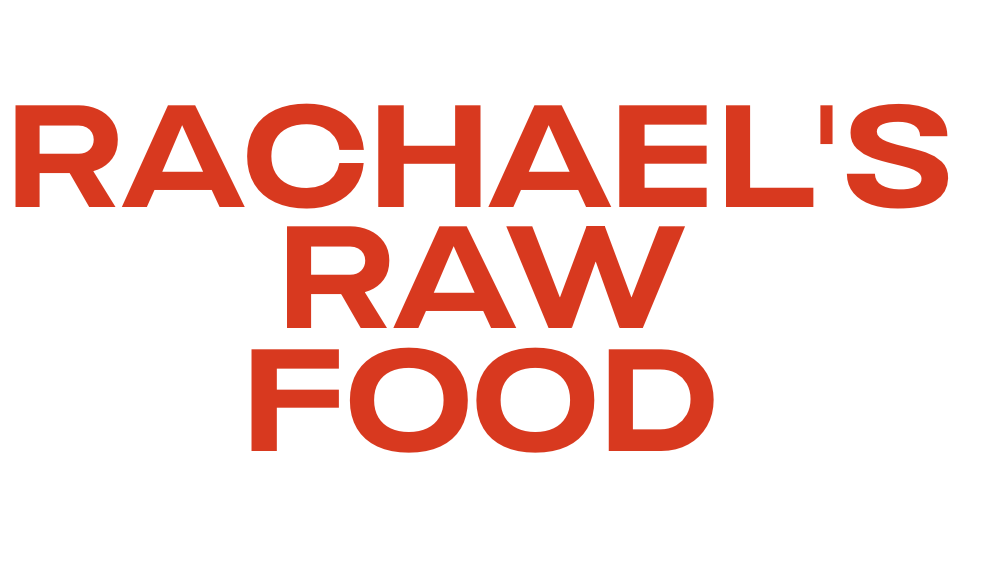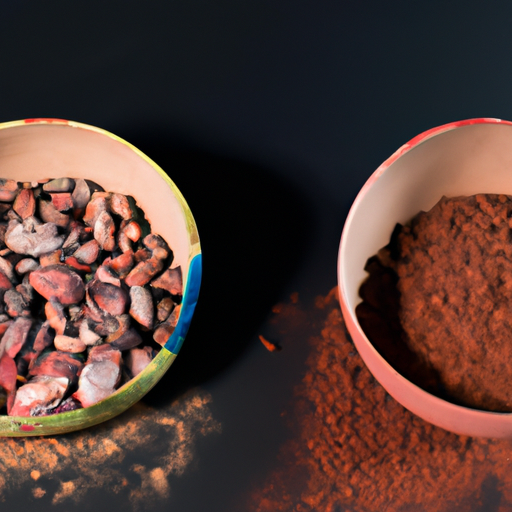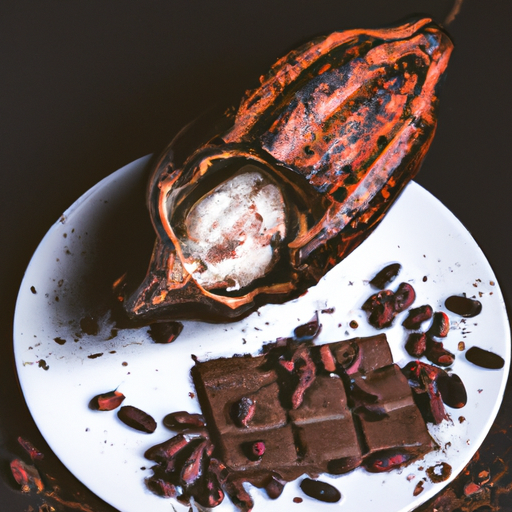One common topic in chocolate conversations is the comparison between organic powdered cocoa and raw cacao. While they are like comparing apples to oranges, each has its own distinct qualities that set them apart.
In this article, I will delve into the origins, processing methods, nutritional profiles, flavor and taste, health benefits, culinary uses, availability and price, as well as certifications and labels of these two chocolate powerhouses.
By understanding the differences, we can make informed choices when it comes to incorporating them into our recipes and diets. So, let’s dive deep into the world of organic powdered cocoa and raw cacao and explore the wonderful possibilities they offer.
Key Takeaways
- Organic powdered cocoa is made by roasting and grinding cocoa beans, while raw cacao is made by cold-pressing unroasted cocoa beans.
- Raw cacao is slightly more expensive than organic powdered cocoa.
- Organic powdered cocoa has a smoother and milder taste, while raw cacao has a more intense and bitter flavor.
- Both options have unique qualities and health benefits, so personal preference and desired flavor profile should be considered when choosing between them.
Origins of Organic Powdered Cocoa and Raw Cacao
So, you’re curious about the origins of organic powdered cocoa and raw cacao, huh? Well, let me tell you, they both come from the magical world of cacao trees!
Organic powdered cocoa is made from the beans of the cacao tree that have been fermented, roasted, and ground into a fine powder. It undergoes a specific processing technique to remove the cocoa butter, resulting in a lower fat content.
On the other hand, raw cacao is made from unroasted cacao beans that have been cold-pressed to preserve the natural enzymes and nutrients. This minimal processing technique helps retain a higher antioxidant content compared to organic powdered cocoa.
Now, let’s delve deeper into the processing methods used for these two delightful cacao derivatives.
Processing Methods
When you’re seeking out that rich, velvety flavor in your favorite chocolate treats, have you ever wondered how the processing methods used for organic powdered cocoa and raw cacao can make all the difference? Here are four key factors to consider:
-
Fermentation process: Raw cacao undergoes fermentation, where the cocoa beans are left to ferment for several days. This process enhances the flavor and reduces the bitterness, resulting in a more complex taste profile.
-
Antioxidant content: The fermentation process in raw cacao preserves a higher level of antioxidants compared to organic powdered cocoa. Antioxidants have been linked to numerous health benefits, including reduced inflammation and improved heart health.
-
Roasting: Organic powdered cocoa is made by roasting the cocoa beans at high temperatures. This roasting process not only alters the flavor but also reduces the antioxidant levels present in the raw cacao.
-
Grinding: Both organic powdered cocoa and raw cacao undergo grinding to create a fine powder. However, the grinding process for organic powdered cocoa often involves additional heating, which further impacts the flavor and nutrient content.
Understanding these processing methods provides insight into the differences between organic powdered cocoa and raw cacao.
Moving on to the subsequent section about ‘nutritional profiles’, it’s fascinating to explore how these variations affect the overall composition.
Nutritional Profiles
Explore the fascinating variations in nutritional profiles as you delve into the world of organic powdered cocoa and raw cacao.
Both these ingredients offer unique benefits and can be used in various culinary applications.
When it comes to antioxidant content, raw cacao takes the lead. It is packed with flavonoids and polyphenols, which have been linked to numerous health benefits, such as reducing inflammation and improving heart health.
On the other hand, organic powdered cocoa undergoes processing that may reduce some of its antioxidant content. However, it still contains a considerable amount of antioxidants and is a healthier alternative to processed cocoa powders.
Moving on to the next section about flavor and taste, it’s important to note that these nutritional differences also influence the overall sensory experience of these ingredients.
Flavor and Taste
When comparing flavor and taste, it is important to consider the differences in flavor profiles, bitterness and sweetness levels, as well as texture and mouthfeel.
The flavor profiles of organic powdered cocoa and raw cacao can vary significantly. Organic powdered cocoa often has a richer, more intense taste compared to raw cacao.
Bitterness and sweetness levels also differ between the two. Raw cacao is generally more bitter, while organic powdered cocoa has a sweeter profile.
In addition to flavor, texture and mouthfeel can also impact the overall taste experience. Raw cacao often has a more coarse and gritty texture, while organic powdered cocoa has a smoother consistency.
These differences in flavor, bitterness, sweetness, texture, and mouthfeel make organic powdered cocoa and raw cacao distinct in terms of flavor and taste.
Differences in Flavor Profiles
If you’re craving a richer, more intense taste experience, organic powdered cocoa is your go-to choice over raw cacao. The flavor preferences of individuals vary, but the deep, robust taste of organic powdered cocoa is often favored by those who enjoy a more pronounced chocolate flavor in their recipes.
Organic powdered cocoa offers a distinct balance of bitterness, sweetness, and acidity that can enhance the overall taste profile of desserts, beverages, and savory dishes. The list below illustrates the emotional response associated with this flavor profile:
- Indulgent: The rich, velvety taste of organic powdered cocoa can evoke feelings of decadence and luxury.
- Comforting: The deep, comforting flavor of organic powdered cocoa can provide a sense of warmth and familiarity.
- Satisfying: The intense taste of organic powdered cocoa can leave you feeling deeply satisfied and content.
When it comes to recipe substitutions, organic powdered cocoa can be used interchangeably with raw cacao in most cases. However, it’s important to consider the flavor impact and adjust the quantities accordingly to achieve the desired taste.
Moving on to bitterness and sweetness levels…
Bitterness and Sweetness Levels
The bitterness and sweetness levels of organic powdered cocoa and raw cacao can transport your taste buds on a rollercoaster ride of flavor.
When it comes to bitterness, raw cacao tends to have a stronger and more pronounced bitter taste compared to organic powdered cocoa. This is because raw cacao undergoes minimal processing, preserving its natural bitterness.
On the other hand, organic powdered cocoa is often processed to reduce the bitterness, resulting in a smoother and less bitter taste.
As for sweetness, both raw cacao and organic powdered cocoa can vary in sweetness levels depending on factors such as the variety of cacao bean used and the processing methods.
Taste preferences play a crucial role in determining which option is preferred, as some individuals may enjoy the bold bitterness of raw cacao while others may prefer the milder sweetness of organic powdered cocoa.
Moving on to texture and mouthfeel…
Texture and Mouthfeel
Smooth and velvety on the tongue, the texture of both organic powdered cocoa and raw cacao can elevate your chocolate experience to new heights. However, there are subtle variations in texture that can enhance the sensory experience in different ways.
-
Organic powdered cocoa: This fine powder has a smooth texture that dissolves effortlessly in liquids, creating a silky mouthfeel. It blends seamlessly into recipes and adds a rich, creamy texture to baked goods and beverages.
-
Raw cacao: The texture of raw cacao is slightly coarser compared to powdered cocoa. It has a gritty feel that adds a delightful crunch to desserts. The small cacao nibs provide a pleasurable textural contrast when incorporated into recipes.
-
Creaminess: Both organic powdered cocoa and raw cacao can impart a creamy texture when used in combination with other ingredients like milk or butter.
-
Melting sensation: When heated, both organic powdered cocoa and raw cacao melt smoothly, enveloping your taste buds in a luscious, velvety coating.
With a clear understanding of the texture variations, let’s now explore the health benefits of these chocolate delights.
Health Benefits
The health benefits of organic powdered cocoa and raw cacao can be observed in three key areas: cardiovascular health, mood and cognitive function, and anti-inflammatory properties.
Consuming these products has been linked to improvements in cardiovascular health. Studies have shown that they can reduce blood pressure and improve blood flow, which are important factors in maintaining a healthy cardiovascular system.
In addition, the compounds found in cocoa and cacao have been shown to enhance mood and cognitive function. This can be particularly beneficial for individuals with conditions such as depression and age-related cognitive decline. The consumption of cocoa and cacao has been associated with improved mood and increased cognitive performance.
Furthermore, cocoa and cacao possess anti-inflammatory properties. Inflammation is a common factor in many chronic diseases, and reducing inflammation in the body can have numerous health benefits. The anti-inflammatory properties of cocoa and cacao can help combat inflammation and potentially reduce the risk of developing certain chronic diseases.
In summary, the health benefits of organic powdered cocoa and raw cacao include improvements in cardiovascular health, enhancements in mood and cognitive function, and anti-inflammatory properties. Incorporating these products into a balanced diet can contribute to overall well-being and potentially reduce the risk of chronic diseases.
Cardiovascular Health
Contrastingly, raw cacao is like a heart-boosting superfood, while organic powdered cocoa is just a regular cocoa powder. Here’s why raw cacao is considered superior for cardiovascular health:
-
Lowering blood pressure: Raw cacao contains flavanols, which have been shown to improve blood flow and reduce blood pressure, thus lowering the risk of cardiovascular diseases.
-
Reducing cholesterol levels: The high levels of antioxidants in raw cacao can help lower LDL (bad) cholesterol and increase HDL (good) cholesterol, promoting a healthier lipid profile.
-
Improving endothelial function: Raw cacao improves the function of the endothelium, the inner lining of blood vessels, by enhancing nitric oxide production. This helps relax blood vessels and maintain healthy blood flow.
-
Antioxidant power: Raw cacao is packed with powerful antioxidants, such as polyphenols, which combat oxidative stress and inflammation, both of which play a role in cardiovascular diseases.
These cardiovascular benefits of raw cacao set it apart from organic powdered cocoa, making it a heart-healthy choice.
Moving on to mood and cognitive function…
Mood and Cognitive Function
If you’re looking to boost your mood and enhance your cognitive function, you’ll be delighted to know that raw cacao has some incredible benefits for your brain. Studies have shown that consuming raw cacao can lead to mood enhancement and cognitive enhancement.
The flavonoids present in raw cacao have been found to increase blood flow to the brain, improving cognitive functions such as memory and attention. Additionally, raw cacao contains compounds that stimulate the production of endorphins and serotonin, which are known to elevate mood and promote feelings of happiness. These mood-enhancing effects of raw cacao can have a positive impact on overall mental well-being.
Moving forward to the next section about ‘anti-inflammatory properties’, it’s important to note that raw cacao also offers additional health benefits beyond mood and cognitive enhancement.
Anti-inflammatory Properties
To enhance your understanding of the health benefits of raw cacao, it is worth exploring its remarkable anti-inflammatory properties.
Raw cacao contains a variety of compounds that have been shown to possess anti-inflammatory effects. Research studies have demonstrated that the flavonoids and polyphenols found in raw cacao can reduce inflammation in the body by inhibiting the production of pro-inflammatory molecules. These molecules play a key role in the development of various chronic diseases, such as heart disease, diabetes, and certain types of cancer.
Additionally, raw cacao has been found to increase the production of anti-inflammatory cytokines, which further contribute to its anti-inflammatory benefits. These findings suggest that incorporating raw cacao into your diet may help to reduce inflammation and promote overall health.
Moving on to culinary uses, raw cacao can be used in a variety of recipes to add a rich, chocolatey flavor without the added sugar and processing of traditional cocoa powder.
Culinary Uses
In culinary uses, organic powdered cocoa and raw cacao bring distinct flavors and textures to recipes, adding depth and richness to both sweet and savory dishes.
Organic powdered cocoa, with its smooth and velvety consistency, is commonly used in baking, hot chocolate, and desserts like cakes and cookies. It lends a rich chocolatey taste and a dark color to these preparations.
On the other hand, raw cacao, with its slightly bitter and nutty flavor, is often used in smoothies, energy bars, and raw desserts. It pairs well with fruits, nuts, and seeds, adding a unique twist to these creations.
Incorporating organic powdered cocoa or raw cacao into culinary applications can elevate the taste and appearance of your dishes, providing delightful recipe ideas.
Moving on to availability and price, both options can be found in specialty stores and online retailers, catering to different budgets and preferences.
Availability and Price
Both organic powdered cocoa and raw cacao are readily available in specialty stores and online retailers, allowing for a range of options to suit various budgets and preferences. The availability and price of these products can vary depending on factors such as the brand, quality, and quantity. Generally, raw cacao tends to be slightly more expensive than organic powdered cocoa due to its less processed nature. However, it is important to note that prices can fluctuate and vary between different retailers. To illustrate this, the table below provides a comparison of the availability and price of both organic powdered cocoa and raw cacao at three popular online retailers.
| Retailer | Organic Powdered Cocoa (8 oz) | Raw Cacao (8 oz) |
|---|---|---|
| Retailer A | $6.99 | $8.99 |
| Retailer B | $7.49 | $9.99 |
| Retailer C | $6.79 | $10.49 |
As we move forward to the next section discussing certifications and labels, it is important to consider the availability and price of these products in relation to their quality and sustainability.
Certifications and Labels
Now let’s delve into the certifications and labels associated with organic powdered cocoa and raw cacao.
When it comes to organic certification, both organic powdered cocoa and raw cacao can be certified organic by reputable organizations. This certification ensures that the products have been produced without the use of synthetic fertilizers, pesticides, or genetic modification.
Additionally, some brands may also carry a fair trade label, indicating that the cocoa or cacao beans have been sourced from farms that follow fair labor practices and provide fair wages to farmers. These labels provide consumers with the assurance that their purchase supports sustainable and ethical practices.
As we move on to the conclusion, it is important to consider all the factors we have discussed so far in order to make an informed choice between organic powdered cocoa and raw cacao.
Conclusion: Making the Right Choice
Ultimately, the choice boils down to personal preference and the desired flavor profile you seek. When making informed choices between organic powdered cocoa and raw cacao, it is important to understand the differences.
Organic powdered cocoa is made by roasting cocoa beans and then grinding them into a fine powder, while raw cacao is made by cold-pressing unroasted cocoa beans, retaining more of their natural nutrients.
Organic powdered cocoa has a smoother and milder taste, making it ideal for baking and cooking. On the other hand, raw cacao has a more intense and bitter flavor, which some people prefer for making beverages like hot chocolate or adding to smoothies.
Both options have their own unique qualities and health benefits, so it’s important to experiment and find the one that suits your taste and nutritional needs.
Frequently Asked Questions
Can organic powdered cocoa and raw cacao be used interchangeably in recipes?
You can use organic powdered cocoa and raw cacao interchangeably in recipes, but there are flavor differences. Organic powdered cocoa has a richer, more intense flavor while raw cacao has a slightly bitter and earthy taste. Both offer health benefits, such as antioxidants and mood-boosting properties.
Are there any potential side effects or risks associated with consuming organic powdered cocoa or raw cacao?
There can be potential side effects and risks associated with consuming organic powdered cocoa or raw cacao, especially in large amounts. It is important to be mindful of the recommended daily intake and consult a healthcare professional if needed.
How does the processing method of organic powdered cocoa and raw cacao affect their nutritional value?
The processing methods of raw cacao and organic powdered cocoa greatly impact their nutritional value. Raw cacao retains more antioxidants and nutrients due to minimal processing, offering greater health benefits compared to organic powdered cocoa.
Can organic powdered cocoa and raw cacao be used in baking or cooking?
Yes, both organic powdered cocoa and raw cacao can be used in baking and cooking. Organic powdered cocoa adds a rich chocolate flavor to recipes, while raw cacao retains more nutrients due to minimal processing. Baking with organic powdered cocoa and raw cacao offers the benefits of enhanced taste and potential health benefits.
Are there any specific certifications or labels to look for when purchasing organic powdered cocoa or raw cacao?
When purchasing organic powdered cocoa or raw cacao, look for certified organic labels like USDA Organic or Fairtrade. These labels ensure the cocoa or cacao has met specific standards for organic farming and fair trade practices. Understanding the difference between organic and non-organic cocoa or cacao is important for making an informed choice.
Is Raw Cacao the Same as Organic Powdered Cocoa?
Yes, there is a difference between baking cocoa vs raw cacao. Baking cocoa is processed with a higher temperature, which removes some of the natural nutrients. Raw cacao, on the other hand, is made by cold-pressing unroasted cacao beans, which preserves more of the original nutrients and antioxidants.
Conclusion
In conclusion, after comparing the origins, processing methods, nutritional profiles, flavor and taste, health benefits, culinary uses, availability and price, as well as certifications and labels, it is clear that making the right choice between organic powdered cocoa and raw cacao depends on individual preferences and needs.
Both options offer unique qualities and can be enjoyed in various ways. Whether you prefer the smoothness of organic powdered cocoa or the raw, intense flavor of cacao, both can be incorporated into your diet to add a touch of deliciousness and potential health benefits.
So go ahead and indulge in the world of cocoa and cacao, and discover the joy they bring to your palate and overall well-being. Remember, the choice is yours to make, and both options offer a delectable journey into the world of chocolate.










